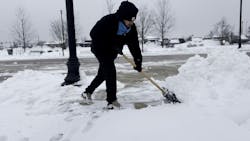How to Assess Your Snow Removal Needs: A Property Manager’s Guide
Property managers face the challenge of keeping their properties safe and accessible during the winter. Assessing snow removal needs effectively requires considering the property type, usage, and location-specific challenges. This guide provides insights into evaluating snow removal needs for different property types, focusing on snow plowing, snow removal, de-icing, salting, and shoveling.
1. Understand Property-Specific Requirements
Different types of properties have unique snow and ice management needs. Here's a breakdown:
Retail Centers
Foot Traffic: High foot traffic throughout the day demands consistent snow removal and de-icing to ensure customer safety. Frequent salting and shoveling is typically necessary, so a thorough and consistent strategy should be in place.
Parking Lots: Large parking areas require efficient snow plowing and a good plan for where to pile the snow. A snow removal company with the capability to clear vast spaces quickly to avoid disruptions is essential for retail centers.
Accessibility: Ensure that entrances and exits are cleared promptly to prevent accidents and maintain a good customer experience. If the flow of traffic isn’t clear, it can deter visitors from returning.
Office Parks
Employee Safety: With employees arriving early and leaving late, maintaining clear paths during peak times is crucial. Coordinated snow plowing and salting services for specific time periods can minimize the risk of slips and falls.
Visitor Parking: Regular snow removal from visitor parking spaces is essential. Signage should be visible and pathways well-marked, even during heavy snowfall.
Property Maintenance: Office parks often have landscaped areas that need protection from de-icing and snow plowing. Establishing specific parameters to keep the landscaping safe is important.
Residential Complexes
Resident Access: Clear and safe walkways, driveways, and parking areas are a top priority. Snow removal must be consistent, with attention given to high-traffic zones.
Emergency Services: Ensure that fire hydrants and emergency access routes are never blocked by snow piles. An effective snow removal plan will prioritize these areas.
Communication: Inform residents about snow removal schedules and provide clear guidelines on parking during snow events.
2. Evaluate the Scope of Snow Removal
Determining the scope of your snow removal plan involves assessing the following factors:
Property Size: Larger properties, such as shopping centers or office parks, may require extensive snow plowing services. It’s essential to partner with a company equipped to handle significant snow accumulation efficiently.
Snowfall Frequency and Intensity: In certain areas, heavy snowfalls can be frequent. It’s crucial to have a proactive snow removal strategy, including pre-treatment of surfaces with de-icing agents to prevent ice buildup.
Property Layout: Identify areas prone to snow accumulation, such as corners, shaded zones, and high-traffic pathways. These areas may need additional attention, such as increased salting or more frequent shoveling. It’s also important to know what equipment is expected to be used for each area. Make sure to communicate any obstacles at the property or areas that require special attention.
3. Choose the Right Snow Removal Services
When evaluating snow removal services, property managers should consider several key factors beyond just basic services of shoveling, snow plowing, and de-icing:
Snow Pile Management: Ensure your property has sufficient space for snow piles. If not, plan for snow hauling services.
Service Plans: Decide between a pay-as-you-go/per-visit service or a seasonal contract. Pay-as-you-go is flexible, but a seasonal option may be more budget-friendly.
Dispatching Triggers: Confirm you’re comfortable with the contractor’s triggers for dispatching services (e.g., at 1 inch or 2 inches of snow).
Contract Duration: Consider whether you want a one-season contract or a multi-season agreement, which can lock in rates and provide consistency.
4. Considerations for Contracting Snow Removal Services
When choosing a snow removal contractor, property managers should evaluate the following:
Experience and Reputation: Look for contractors with a proven track record in your area. Check references and reviews to ensure they are reliable and responsive during snow events.
Technology and Equipment: Contractors using modern equipment and technology can offer more efficient and reliable services. GPS tracking, for example, ensures that snow removal is timely and consistent.
Contract Flexibility: Consider contracts that allow for services based on what you need. A flexible contract can save costs during milder winters while ensuring robust service during heavy snowfalls, but a multi-year seasonal contract can keep the headaches away if you find the right company.
Risk Management: Ensure your snow removal plan includes liability protection. A clear contract with your snow removal company should outline responsibilities for accidents or damage resulting from inadequate snow removal.
5. Prepare for the Winter Season
Pre-Season Inspections: Conduct thorough inspections before the first snowfall. Identify and address potential hazards, such as uneven pavement or poorly drained areas, to reduce winter risks.
Staff Training: Ensure that on-site staff understands the snow removal plan and knows how to handle emergencies. Regular communication between property managers and snow removal contractors is key.
Contingency Plans: Have backup plans in place for severe weather events. This could include additional equipment or secondary contractors to handle unexpected snowstorms.
Conclusion
Effective snow and ice management is vital for property managers. By understanding the unique needs of your property type and choosing the right services, you can ensure safety and accessibility throughout the winter months. Partner with a reliable contractor who understands the local climate and can offer a tailored snow removal plan that meets your specific needs.
Implementing a comprehensive snow removal strategy will not only protect your property but also provide peace of mind for tenants, customers, and employees alike.
About the Author
Tom Marsan
Tom Marsan is a certified snow professional who has been in the landscaping and snow removal industry for about two decades. He is an active member of ILCA and SIMA and is currently the General Manager at Beverly Companies in Chicagoland.
